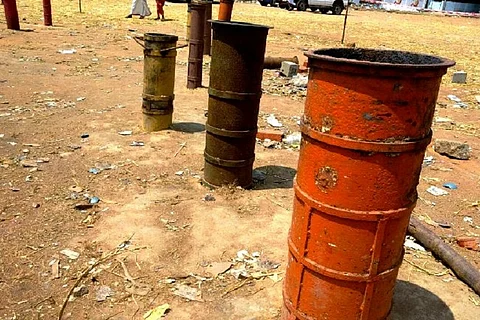

Every year the Puttingal temple witnesses a literal battle of fireworks between two competing groups striving for just that spectacular finish to end on a winning high.
Speaking to the residents staying adjacent to the Puttingal Devi temple at Paravur where 110 people lost their lives and over 300 were injured, one realizes that the annual pyrotechnic display that marks the culmination of the week-long ‘Meena Bharani Mahotsavam’ is more than just fireworks on a grand scale.
“Do you know ours is the only temple in South India which has not just one but two ‘Kambapuras’…well till Sunday, there were two,” says Advocate Arun Lal who stays hardly a few metres from the temple.
A Kambapura is a kind of open shed traditionally endowed with a coconut fronds-plaited roof where crackers and bombs used for such festivities are stored. The Puttingal temple however had erected two elaborate open cemented structures with a concrete roof to serve as their Kambapuras.
It was one of these that came crumbling down, with huge chunks of concrete getting blasted almost two kilometres away, thereby spreading the on-ground extent of damage over a wider area.
“If we had just stuck to the traditional Kambapuras, maybe the tragedy would not have taken on such massive proportions. Do you know that most people who died or were grievously injured had injuries sustained from being hit by flying debris? Unlike what’s believed, not many were burnt,” says Arun.
The Casualty Medical Officer on duty at the Kollam District Hospital Dr. Harish confirmed the same to TNM when he revealed that most of the injured who were brought in had primarily more of lacerated wounds in which debris particles were embedded rather than actual burns from the blast.
The festival is celebrated in honour of the goddess who is enshrined as the deity in the temple on the day the ’Bharani’ star in the Malayalam month of Meenam is on the ascend.
The fireworks associated with the temple’s festivities have long been a bone of contention among the devotees in terms of the extent of fireworks that were actually needed to appease the deity.
But one thing they do all agree on is that the fireworks must go on.
Competitive Fireworks
The ‘Kambam’ as it is usually known is divided into four segments. First comes the ‘Padayottam’ where a series of crackers are burst first by one group and then the next.
This is followed by the ‘Varnapakittu’ which loosely translates into a literal burst of colours released by the next batch of crackers onto the night sky. The third round is ‘Mukhaamukham’, a face-off between the two rival groups.
And then the final ‘Poraattam’ which is the actual fight that seals the winner. It’s also commonly known in local parlance as ‘Ashaanteh Ishtam’ (as per the Maestro’s wish).
Ashaan refers to the leader of each of the competing groups which consist of around 10-15 team members. Simply put, the last-round battle can be fought as per the whims of the leader, a kind of blank cheque handed over to the group to strive for maximum impact, in terms of fireworks.
What went wrong
Owing to the ban imposed on competing this year, the temple authorities chose to showcase this year’s ‘Kambam’ as a joint display by the two groups led by Varkala Krishnankutty and Kazhakuttam Surendran respectively, at least that was what was officially projected to the district authorities.
So instead of the usual procedure of having the two groups competing from the two Kambapuras respectively, both the groups had to host their fireworks from just one Kambapura to avoid any semblance to a competition.
The rivalry however was very much intact with both groups racing against time to come up with the ‘better’ bang. So each group had lined up five to six ‘ammittu’ (a kind of cracker-bomb some of which weighed almost 16 kilos) which in itself was dangerous in case of a misfire. Three vehicles loaded with these bombs were also on standby.
Witnesses say that team-members were seen hugging the amittu close to their chest so as to avoid time-lag between each blast. One of the 'amittu' did not rise high enough and exploded just six to seven feet of the ground. The ensuing sparks from the blast fell onto the lined up ‘ammittu’ which caused a lateral explosion that then spread to the nearby vehicles, triggering off the massive explosion and bringing down the entire Kambapura too in a matter of minutes.
What then followed was the biggest man-made tragedy to be etched in the annals of Kerala till date.